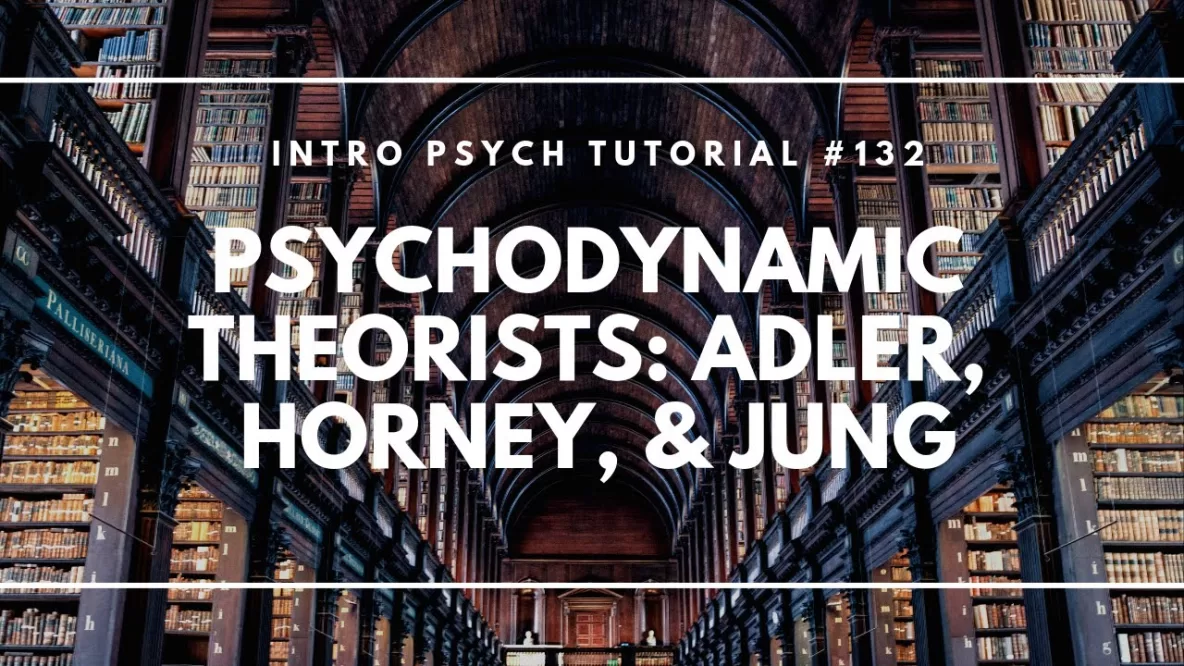In this video I briefly describe some critiques and concepts introduced by the Psychodynamic theorists or Neo-Freudians. Alfred Adler disagreed with Freud’s emphasis on sexual and aggressive drives and proposed social tensions as important in the development of an inferiority complex or strive for superiority. Karen Horney considered penis envy to be male-centric and proposed womb envy. Carl Gustav Jung also disagreed with Freud’s emphasis on sex and aggression and believed aims and aspirations were important, as well as the conflict within the individual. Jung also proposed the idea of a collective unconscious, filled with symbols and archetypes that were shared and recognized by all people.
Don’t forget to subscribe to the channel to see future videos! Have questions or topics you’d like to see covered in a future video? Let me know by commenting or sending me an email! Check out my book, Master Introductory Psychology, an alternative to a traditional textbook: http://amzn.to/2eTqm5s
Video Transcript
Hi, I’m Michael Corayer and this is Psych Exam Review. In the past few videos we’ve looked at how Freud’s ideas relate to personality and personality development. In this video I’d like to take a look at how Freud’s ideas influenced the next generation of theorists. These are the psychodynamic theorists or the Neo-Freudians.
Now these psychodynamic theorists shared a lot of common ground with Freud but they disagreed on some of the details. So two things that they shared where they believed that unconscious influences were fundamental for understanding behavior, and they also believed that early childhood experiences were important for shaping personality.
So the first theorist that we’ll look at is Alfred Adler. And here’s a picture of Adler, almost dabbing here, and Adler disagreed with Freud when it came to his emphasis on sex and aggression. So Adler thought that while we do have sexual and aggressive drives that these weren’t the most important aspects of understanding personality. And so he placed emphasis on social tensions and he thought that our social tensions had the potential to create things like an inferiority complex, or on the positive side, it could create a strive for superiority.
Alright next we’ll look at Karen Horney. And here’s a picture of Horney here, and Horney disagreed with Freud in that she felt some of his theories were overly male-centric. In particular, his suggestion that all females experience penis envy as an important part of their normal development and so in contrast to this idea Horney proposed the idea of womb envy. This is the idea that men are jealous of women because women have the ability to give birth and bring new life into the world and she thought that this could create unconscious fears or drives in men that would cause them to want to dominate or disparage women.
Ok, lastly we’ll look at probably the most famous of the neo-Freudian psychodynamic theorists and this is Carl Gustav Jung. And here’s a picture of a young Jung. Like Adler, Jung disagreed with Freud in his emphasis on sexual and aggressive drives and what Jung proposed instead was an emphasis on people’s aims and aspirations. He thought these were the more important drives motivating behavior. And unlike Adler, who emphasized social tensions, Jung believed that the focus of conflict should be considering the conflict within the individual rather than conflict with society or conflict with reality.
Now Jung is also known for a few other concepts and probably the most famous of these is his idea of a collective unconscious. And so the idea of a collective unconscious is that not only do we have our own unconscious, which contains wishes, desires, and fears, but there’s also a shared form of the unconscious that everyone has. This is the collective unconscious and so it contains things that we would all recognize; it contains universal symbols, motifs, and memories that have been passed down through generations. And so they’re shared by all humans and one example of something that will be in the collective unconscious is the idea of an archetype.
So archetypes refer to these universal motifs that present ideas like devils, heroes, tricksters, and sages and that these are sort of archetypal characters that people all over the world could recognize and that we would find these in stories and in literature. And we could immediately recognize these presentations even though they might vary slightly from culture to culture; that they would still be universal. So one way you could think about archetypes, if you think of really popular films like Star Wars, or, you know, popular Disney movies like The Lion King and the idea that people from many different cultures could see these stories and identify the heroes and the devils and trickster characters because these, Jung would said, were part of the collective unconscious that we all share.
Ok, so this is a basic introduction to some of these other psychodynamic theorists and I’m not going to go into a lot of detail as most introductory classes don’t, but maybe this is something that I can come back to and talk about in future videos. And we will come back to some of the psychodynamic ideas when we talk about treatment in a future unit. Ok, I hope you found this helpful, if so, please like the video and subscribe to the channel for more. Thanks for watching!

